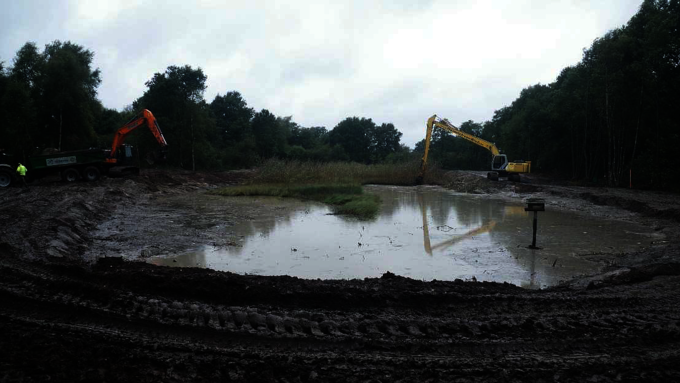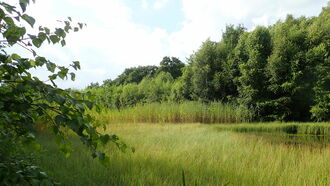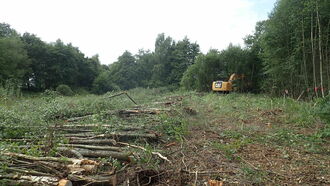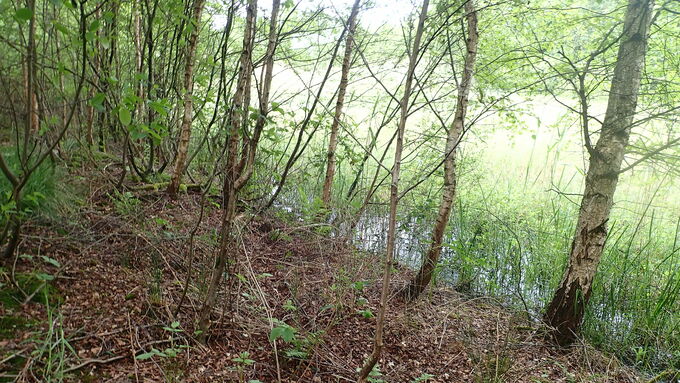The formerly open waterbody was densely surrounded by woods before the implementation of the measures started. © Thomas Kutter, NLWKN
download picturemain content
Project of the month
#01/2023 Clearing and shallow water zones (District of Ammerland)
New opportunities for the floating water-plantain in the SAC ‘Holtgast’
The 34-hectare nature reserve ‘Holtgast’ is located west of Westerstede in the East Frisian Geest and was placed under protection as early as 1942. Of particular importance for endangered plant species in this area is a relatively nutrient-poor small waterbody. The area was also registered as SAC in 2005 for this reason. The so-called ‘Schlatt’ – Low-German for a shallow, occasionally dry small waterbody - used to lie open in the wide landscape without surrounding forest. Floating club-rush (Isolepis fluitans), lesser water-plantain (Baldellia ranunculoides) and lesser marshwort (Helosciadium inundatum) occurred here in recent decades and the rare floating water-plantain (Luronium natans) also found good growing conditions in the waterbody until it disappeared in 2019. This is the only location of the floating water-plantain in the district of Ammerland. In 2021, the common frogbit (Hydrocharis morsus-ranae), the purple marshlocks (Potentilla palustris) and the common pillwort (Pilularia globulifera), among others, could still be detected. Nevertheless, it became apparent that the waterbody was increasingly losing its function as a habitat for the specialised plant species due to the colonisation of young woody plants on the edge as well as siltation. This was also reflected in the classification of the habitat type 3130 (oligotrophic to mesotrophic standing waters with vegetation of the Littorelletea uniflorae and/or of the Isoeto-Nanojuncetea) as of poor conservation level C.
The LIFE IP team, together with the Lower Nature Conservation Authority of the District of Ammerland, therefore organised the appropriate steps for an action to reactivate the floating water-plantain and restore the original conditions. The works were carried out in agreement and with the consent of the private owner. In September 2022, the first step was to cut down the woody plants around the waterbody so that the nutrient input from foliage was reduced. The timing was chosen to cause as little damage as possible to the special flora and fauna in the entire protected area. Afterwards, a forestry mulcher worked a ring several metres wide around the waterbody with the aim of destroying the root stumps and preventing them from leafing out again. For future management with machines, this ring was stripped off with an excavator and levelled out. The removed material was tipped as a ridge on the edge of the directly adjacent field. In the future, a hedge bank will be created here.
Since the floating water-plantain has very resistant, long-lived seeds, the pioneer species can be reactivated with the help of targeted desludging to create good germination conditions for the existing seed bank. Therefore, another chain dredger was used to desludge an area of about 2,900 square metres of the waterbody and to create suitable shallow water zones at the edges. The average working depth was around 20 centimetres. In addition, the partly very dense rush vegetation in the waterbody was removed. A small area in the middle was spared as a refuge. The construction works were ecologically monitored by a biologist. After analysis of the soil samples and with the consent of the tenant, the resulting sludge was spread on the directly adjacent field. This made it possible to avoid longer transports. The spreading was carried out with a manure spreader.
Upon completion, the cleared waterbody with its new shallow water zones is quite impressive! The next few years will show to what extent the floating water-plantain can now gain ground here again. After this initial restoration, human intervention will still be necessary to preserve the local biodiversity. The waterbody also provides an important habitat for dragonflies in the current landscape. There are special records from the nature reserve from the 1980s and 1990s for 15 dragonfly species, including the emerald spreadwing (Lestes dryas, Red List 3) and the Irish damselfly (Coenagrion lunulatum, Red List 1).
Related Topics
Further Links
- Implementation notes for the protection of the floating water-plantain – Lower Saxony Water Management, Coastal Defence and Nature Conservation Agency (NLWKN) (in German) (external link opens in a new window)
- District of Ammerland - Department for Environment and Climate Protection (in German) (external link opens in a new window)
- Nature reserve ‘Holtgast’ - Lower Saxony Water Management, Coastal Defence and Nature Conservation Agency (NLWKN) (in German) (external link opens in a new window)
- SAC ‘Holtgast’ - Lower Saxony Water Management, Coastal Defence and Nature Conservation Agency (NLWKN) (in German) (external link opens in a new window)







